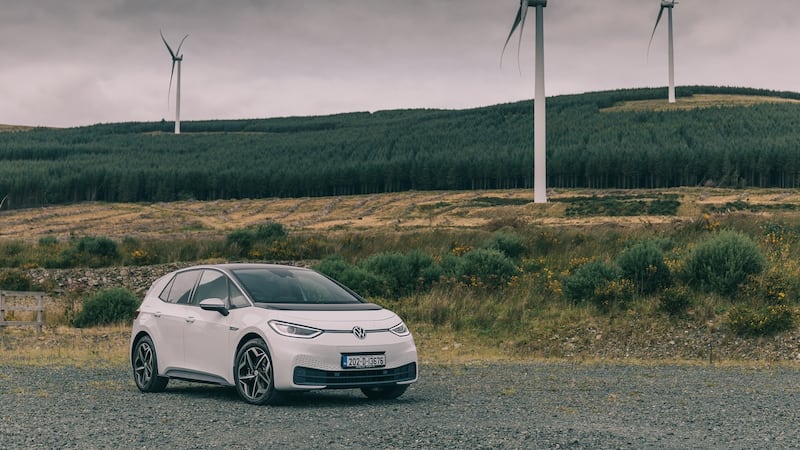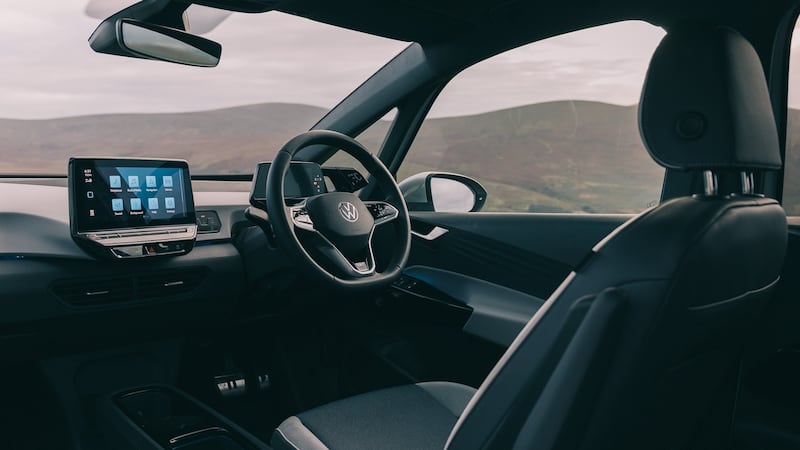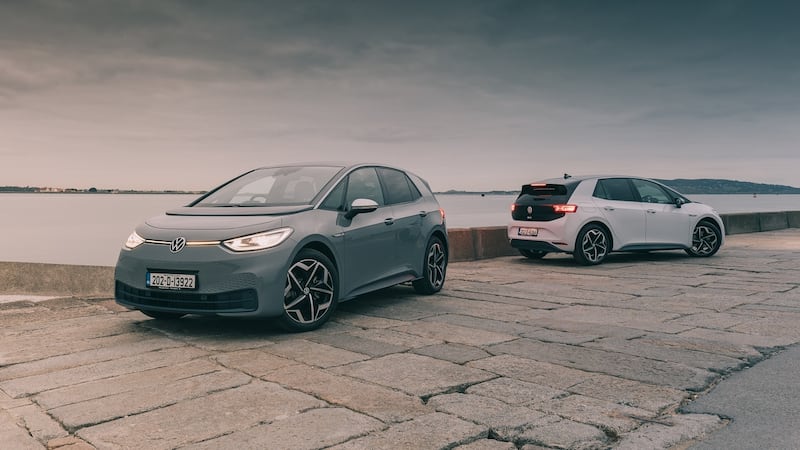There is a lot riding on the rubber of the new Volkswagen ID.3. This car is meant to follow in the tyre tracks of the original VW Beetle and more recently the Golf. The ID.3 is to be an epoch-making motor.
There is revolution in the air in the auto industry. The old guard is being challenged more existentially than at any time since Bertha Benz shouted down the hall that she was going for a drive.
In an article last Saturday, my colleague Derek Scally highlighted a symbolic turning point that took place this month, as Germany's powerful car companies once more went cap-in-hand to its government looking for taxpayer support. They got nothing but "vague, aspirational noises". How times have changed.
Contrast that to the visit nine days earlier by Elon Musk, turning the sod at Tesla's upcoming gigafactory outside Berlin. Musk got face time with Angela Merkel and was treated like a rock star. Elon was met with open arms, the homegrown car execs got short shrift and a closed wallet.

At the end of the trip, Derek reports that Musk even made a visit to meet VW boss Herbert Diess and drove the ID.3. His review: “For a non-sports car it’s quite good.”
The symbolism of the Musk fanfare can't be over-estimated in the context of the importance of the auto sector to the German soul. These are the people who gave us the car. Tesla is the same age as Greta Thunberg.
Talking about the ID.3 in the context of the car to save the motoring establishment will cause owners of Nissan Leafs or BMW i3s to cry foul. They've been running on electric for a decade or so. Yet these were forays into the electric world. The ID.3 represents a full-blown leap.
The good news for Volkswagen is that it has secured a safe landing.
In styling terms, the new ID.3 makes the evolution to electric without abandoning the traits of traditional hatchback formats. It’s a good-looking car, noticeably benefitting from the decision to fit large alloys (starting at 18 inches and going up to 20 inches). The subtle styling touches are enough to catch the eye without making it look too radical for VW’s traditionally conservative customer base.
Inside is a pleasant surprise: given the ID.3’s profile you expect to encounter a Golf-sized cabin, but this is notably bigger. Legroom front and rear is on a par with a family saloon and two adults in the back could easily stretch their legs.
The roofline is also deceivingly quiet tall, which makes you reach for the front seat adjusters when you get in, as you feel like you’re sitting too low. And that’s when you encounter the plastic. For all the multi-billion R&D spend on this car, it’s clear the engineer designated to dress up the more rudimentary fittings was sent to take stock from the parts bin of the Polo production line.
In contrast, the eyeline-level fixtures and fitting are of impressive quality and boasting new tech. A large 10.5-inch touchscreen controls nearly every function in the car. The small driver’s display is fitting to the adjustable steering column. But given the limited level of information on its display, it’s clear which screen comes first.
VW clearly wants the ID.3 to showcase its new skillset. This German industrial behemoth isn’t just a dab hand at pressing metal: it can do tech.
So we get swish graphic displays, haptic touch controls on the steering wheel and a overly-engineered electronic switch system for the driver to operate the rear electric windows. With all the in-car tech gadgetry, VW is seeking the wow factor; instead it elicits more ho-hum.
You see when opting for a Volkswagen, your money doesn’t just buy you a pile of moving metal. It should also be the result of experienced management and decades of automotive nous. And that means managers with the ability to shout stop. With some of the tech on ID.3, no one made that call.

The touchscreen system seems to suffer from slow processing speed, at least in the first few minutes when the car starts. It’s as if the system needs time to boot up. Perhaps VW needs to come up with its own version of Microsoft’s flag or Apple’s spinning wheel.
But then why should we expect top-level tech first time out. If it was that easy every country would boast a tech giant, not merely some back offices for the US ones.
The ID.3 showcases what Volkswagen does best: build quality cars. From the light clunk of the doors, to the tick of the indicator, this car feels like a nice place to be when you take to the road.
It offers a level of driving refinement that’s unmatched by any of its similarly-priced rivals. Take the throttle response: it’s neither the jerky full-blooded acceleration of some early electric “sports” cars. Nor is it a copycat of a traditional fossil-fuelled drive. It neatly delivers its 204bhp to the road.
Rivals also suffered from wheelspin when you kicked down on the accelerator, but the ID.3 manages to find the sweet spot between pace and grip.
Particularly impressive are the brakes, smooth and grippy with plenty of early reassuring bite. We’ve noticed in too many new electric models of late that the first touch often too spongy: not here.
Ride quality and cornering are also really impressive. The latter is an unsurprising trait given the low centre of gravity. But, the ID.3’s ability to soak up the bumps and yumps of Irish tarmac and still keep the driver feeling connected to the road – not flopping around on an oversprung sofa – is something rival electric cars still need to master.
The ID.3 boasts a range of between 410km and 424km from the 58kWh battery pack, depending on the car’s specification. In reality that is probably going to deliver over 300km or so in everyday driving. That’s enough for most Irish motorists. Recharging is easy and with that sort of range, you wouldn’t be doing it every day in any event.
Electric is no longer a risky option for most motorists, provided they can plan ahead for major rural grand tours. The range issue is largely sorted, with 300km on offer from this car and several similarly priced rivals; enough to avoid you having to plug in every night and certainly enough for the daily commute.
The public charging network remains a work in progress and needs serious improvements not only in geographic spread, but also in terms of reliable information on when a charger is working or not. However, for most motorists it will not be a deal breaker.

So, as Neil Briscoe writes this week, the biggest hurdle electric cars need to overcome now are the prices.
After the various grants, you are looking at €32,915 for the first edition ID.3, a drop of €710 on the initial published price last June, when the car’s were supposed to be on the road. And in truth, in the current climate, a bit more discount might be had on the forecourt.
Step up to the Plus grade and the price leaps to €39,770. Frankly, after inspecting the equipment list, it’s not worth the extra cash. And forget about the Max version at €46,610.
You could, of course, also wait for the smaller battery version, which will come with a lower price tag, but with so many people still concerned about range anxiety, it’s probably not the one to choose. There is also a larger 77kWh battery pack version on the way early next year, promising 600km. But it will carry a higher price and have only four seats.
In reality, the best buy seems the entry-level here and even then you have to consider what’s coming down the line. As early as February we may see the larger ID.4, a crossover sized all-electric car that’s probably going to be the best-seller if the price is right. Over at sister brand Skoda, the all-electric Enyaq crossover lands in April, though with only 270 coming here, you’re probably already too late to get your name on that order list.
In summary, Volkswagen has delivered a new electric car that is worth buying. It’s better to drive than similarly priced rivals, with a build quality we’ve come to expect from VW hatchbacks. What lets it down is some of the ancillary tech.
In the battle for the future of the automotive world, we are getting a clearer profile of the protagonists thanks to cars like this.
On one side is a company with a proven track record in building quality cars but a novice when it comes to tech, competing against the likes of Tesla, a tech company that is struggling to build quality cars. Merkel and every motorist wondering about their next car will be interested to see how this plays out. The question being asked: can VW become Tesla, before Tesla becomes VW?
VW ID.3: the lowdown
- Power 58kWh battery pack delivering 204hp and 310Nm of torque
- 0-100km/h 7.3 secs
- Official range 410-424km
- Charging time on 7.4kW charger 0-100% 9h 30mins
- Price €39,770 as tested after various grants (prices start from €32,915)
- Verdict Well-built, good-looking and nice to drive – room for improvement with the in-car tech














